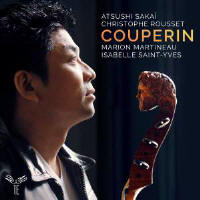Texte paru dans: / Appeared in: |
|
|
Reviewer: Bertil
van Boer
We tend to equate the Couperin
family, as important a musical dynasty in France of the grand world of Louis
XIV and XV as can be found, with keyboard music. As important as the
harpsichord was during the early part of the 18th century, many of the court
composers also favored the viol, thanks to the efforts of the Sieur de
Sainte-Colomb and Marin Marais, who took it to its highest level of
popularity and technical achievement. It has been known that virtually all
composers of the age wrote for the instrument, either solo or in consort,
but until recently François Couperin’s music was lacking. In his fourth book
of keyboard works, he hinted in the preface that he had in fact written a
group of works for viol and harpsichord, and this disc reflects it
rediscovery relatively recently.
The Pièces are arranged in
suites, just like the published keyboard sets, and here for the first time
we have both of them recorded by gambist Atsushi Sakaï and harpsichordist
Christophe Rousset. Since the 1728 publication is too short for an entire
disc, the artists have filled it out with two pieces by Antoine Forqueray,
one of Couperin’s more interesting contemporaries. These are for a trio of
viols and continuo, with two additional instrumental performances by Marion
Marineau and Isabelle Saint-Yves. Finally, even this is not enough, so an
additional “Plainte” for a pair of viols and continuo by Couperin from 1724
and an occasional piece by Forqueray entitled “La Girouette,” a sort of
small weathervane, are added.
The last sort of rolls around,
with slippery scalar figures and sequences that bring to mind the variable
wind that rocks the pennant. Rhythmically it is quite distinctive, with
various small alterations occurring continuously. The “Plainte” is quite
reflective, with lush harmonies flowing like a river. The viols, in parallel
thirds and sixths, lend it a full texture, even though the theme itself is a
bit repetitious. The main focus, of course, is on the viol suites. In the
First, in E Minor, the final chaconne is a stately set of variations, each
of which contain some impressive figuration. Here Couperin demonstrates his
knowledge of the capabilities of the instrument, particularly in its use of
all registers. The tone is full and sonorous. A more somber mood affects the
Courante earlier in the suite, with two levels of melodic material, very
much in the vein of the solo suites of the time. The harpsichord plays a
minimal role, and the viol ranges over its entire compass to produce some
lovely deep textures and emphases. The Gigue is spare and precise, with the
rolling triplet meter interrupted by subtle ornamentation. The Second Suite
is of a different character entirely, making it seem like they were composed
some time apart (though published together). In A Major, it begins with a
rolled, arpeggiated prelude that, like the Bach Cello Suites, seems to have
two lines, each complementing the other in a sonorous and regal
juxtaposition. The short “Fugette” is more like a set of ostinato variations
than counterpoint, with lots of tricky and intricate ornamentation in both
lines. This is a real challenge to perform, given that both parts on the
single instrument are of equal importance. This is followed by a softer,
more reflective “Pompe funèbre” that is full-textured and hardly funereal.
Finally, it ends with “La Chemise blanche” (that is, The White Shirt), which
swirls about in an almost perpetual motion, with the line twisting and
turning continuously. Of the Forqueray suite for the trio of viols, it only
needs be said that we have some beautiful and full-bodied consort music
here. The instruments blend conspicuously into a wave of sound that has
depth and contour, especially in the Allemande and the solemn Sarabande. As for the performance, there can be no doubt that this is an excellent disc. The often tortuous roulades and ornaments are performed with such ease by gambist Sakaï that one thinks them an integral part of the line, not just added spice. Harpsichordist Rousset is at his usual best, with a nice sense of integration with the viols throughout. He knows when to keep the registrations subtle, and yet his foundation provides just the right underpinning of these well-rounded works. The other viol players also show their talent in creating fine and resonant textures. These works demonstrate that Couperin was equally adept at writing for the viol, and it is a pity that he did not compose more for the instrument. But the performances here show that he deserves his high reputation as a composer of the late Baroque and are highly recommended. | |
|
|
|
|
|
|
|
Cliquez l'un ou l'autre
bouton pour découvrir bien d'autres critiques de CD |
|




